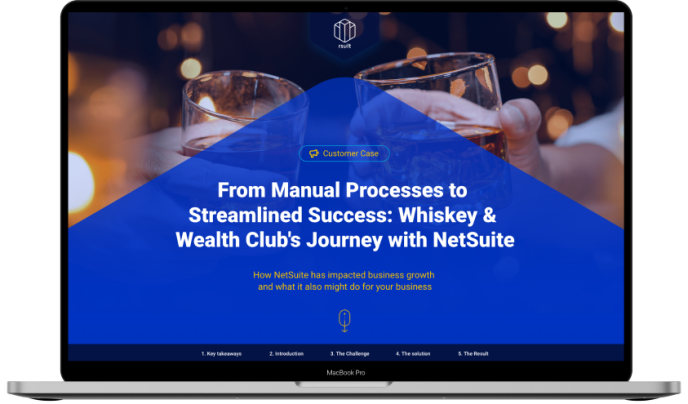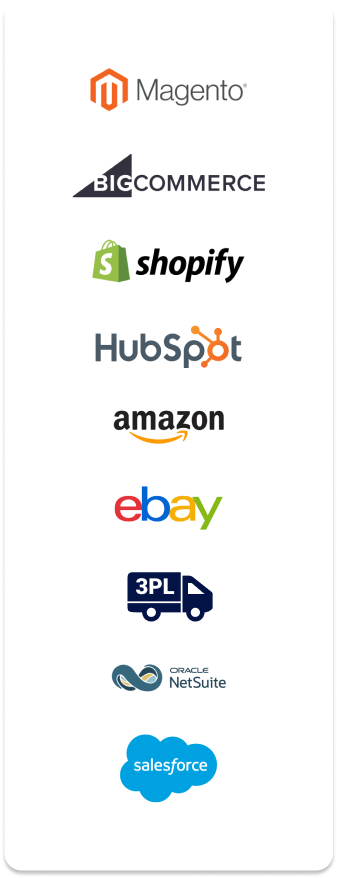👉 STEP 2 Choose a Viable Collaboration Partner
CHAPTER 5/5

CONTENTS
👉 STEP 1 Understand Your Business Needs
👉 STEP 3 Choose a Robust ERP Solution: NetSuite
👉 STEP 4 Bridge the Gap with a Powerful Integration Platform: Celigo
👉 STEP 5 Optimize, Review, and Improve
Discover the capabilities of top-tier ecommerce solutions with NetSuite and Celigo Integration



👉 What are your scaling plans?
👉 What type of customers are you targeting?
👉 What is your sales process?
👉 What is the nature of your product or service?
PEOPLE: Implementing and integrating new systems is a team effort. Ensure the right personnel are involved. PROCESSES: Be ready to articulate your business model, processes and system requirements. PRIORITIES: Consider breaking the project into multiple phases - and avoid building a death-star! Phase 1 might simply be a like-for-like replacement of your existing system(s), but with the added advantage of scalability / future-proofing.
👉 STEP 1



🚀 Strategic Alignment: Partner aligns with business goals, leveraging knowledge and insights to drive long-term success.
💡 Ongoing Support and Maintenance: Reliable partner provides ongoing support, addresses issues, and stays updated with system upgrades.
Why choosing the right collaboration partner is essential for success
⏱️ Time and Cost Efficiency: Partner reduces implementation time, minimizes disruptions, and maximizes return on investment.
⚙️ Seamless Integration: Partner ensures smooth integration, handles data mappings, customizes workflows, and optimizes system performance.
🎓 Expertise and Experience: Partner's expertise and experience save time and resources, navigate challenges, and implement best practices.
When building your B2B eCommerce stack, selecting the right collaboration partner is a vital step that is often overlooked, but holds immense importance. A reliable collaboration partner can significantly impact the success of your implementation and ensure a seamless integration of your chosen solutions. Avoid working solely with the software vendor(s), to whom you are justanother 'logo'. Find a partner who aligns with your company and your team and sees you as a valued client.
To avoid overlooking this crucial step, take the time to evaluate potential collaboration partners based on their experience, (they are only as strong as their current team) track record (what do their customers say?), and ability to understand and align with your business goals.
By prioritizing this step, you can ensure a smooth, efficient, and scalable integration that sets your business up for long-term growth and profitability.
👉 STEP 2



The Enterprise recourse Planning (ERP) system is the backbone of the e-commerce tech stack. it integrates all core back-office business functions: - supply chain, cuch as inventory management, customer relationship management, customer relationship management (CRM), and financial tracking, into unified system NetSuite is the top choice. born online in 1998 now boasting 36,000 business customers in 217 countries, all automatically upgraded twice a year to the latest release and getting acces to the latest feature. Among NetSuite's most standout capabilities, is multi-company/country and consolidation, making. It a no-brainer renowned for it's ambitious brands that have aspirations to scale internationally.
When it comes to B2B eCommerce, NetSuite offers several advantages:
✅ Scalability: NetSuite's cloud-based solution allows for easy scaling as your business grows.
✅ Real-Time Data Access: With NetSuite, you have access to real-time business data, facilitating informed decision-making.
✅ Seamless Integration: NetSuite integrates seamlessly with your eCommerce platform, ensuring smooth information flow between different business functions. Additionally, NetSuite is the only solution that offers a 360 degree view of the customer, the product and the supplier.
👉 STEP 3
ERP Solution: NetSuite



CASE STUDY



Here's why Celigo is a worthy addition to your tech stack:
Pre-Built Integrations: Celigo offers pre-built integrations for popular business apps, significantly reducing the time and effort for integration.
Scalability: Celigo's platform is scalable, meaning it can handle increased data volume as your business grows. With Celigo iPaaS you can integrate additional systems as needed (ecom, PIM, ERP, CRM, market places - and more)
Improved Efficiency: By automating data transfer between systems, Celigo eliminates the need for manual data entry, reducing errors and improving efficiency.
Self-sufficiency: low-code / no-code interface, reduces reliance on developers and puts you in control

Integrating your ERP to other systems (like CRM, webstore and market places) can be a daunting prospect. Modern integration platforms (or iPaaS) like Celigo have revolutionised the 'middleware' landscape, reducing cost and accelerating implementations. Celigo not only bridges the gaps between systems, but simplifies and demystifies the integration process, with prebuilt and configurable connectors to the most popular end-points - and a no/low-code interface.
STEP 4









Craig Matusinski
Kevin’s WorldWide, Coffee Inc.
“I found it to be very user friendly and any tweaks or changes that I’ve had to make have been very easy and the errors are very clear. When you run into an issue its very easy to tell what the problem was.”

To conclude, a powerful B2B eCommerce stack is within reach using the state-of- the-art system like NetSuite and Celigo, if implemented correctly by your best people alongside the right collaboration partner, based on a thorough understanding your unique business processes and priorities. Then, by committing to a roadmap of continuous improvement, you can build the B2B eCommerce tech stack to rule them all!
Lastly, remember that building a tech stack is not a one-time activity. As your business evolves, so will your needs. Regularly review and optimize your tech stack to ensure it continues to serve your business effectively.
👉 STEP 5

👉 STEP 2 Choose a Viable Collaboration Partner


CONTENTS
👉 STEP 1 Understand Your Business Needs
👉 STEP 3 Choose a Robust ERP Solution: NetSuite
👉 STEP 4 Bridge the Gap with a Powerful Integration Platform: Celigo
👉 STEP 5 Optimize, Review, and Improve
Discover the capabilities of top-tier ecommerce solutions with NetSuite and Celigo Integration
PEOPLE: Implementing and integrating new systems is a team effort. Ensure the right personnel are involved. PROCESSES: Be ready to articulate your business model, processes and system requirements. PRIORITIES: Consider breaking the project into multiple phases - and avoid building a death-star! Phase 1 might simply be a like-for-like replacement of your existing system(s), but with the added advantage of scalability / future-proofing.
👉 STEP 1
👉 What are your scaling plans?
👉 What type of customers are you targeting?
👉 What is your sales process?
👉 What is the nature of your product or service?



🚀 Strategic Alignment: Partner aligns with business goals, leveraging knowledge and insights to drive long-term success.
💡 Ongoing Support and Maintenance: Reliable partner provides ongoing support, addresses issues, and stays updated with system upgrades.
Why choosing the right collaboration partner is essential for success
⏱️ Time and Cost Efficiency: Partner reduces implementation time, minimizes disruptions, and maximizes return on investment.
⚙️ Seamless Integration: Partner ensures smooth integration, handles data mappings, customizes workflows, and optimizes system performance.
🎓 Expertise and Experience: Partner's expertise and experience save time and resources, navigate challenges, and implement best practices.
When building your B2B eCommerce stack, selecting the right collaboration partner is a vital step that is often overlooked, but holds immense importance. A reliable collaboration partner can significantly impact the success of your implementation and ensure a seamless integration of your chosen solutions. Avoid working solely with the software vendor(s), to whom you are justanother 'logo'. Find a partner who aligns with your company and your team and sees you as a valued client.
To avoid overlooking this crucial step, take the time to evaluate potential collaboration partners based on their experience, (they are only as strong as their current team) track record (what do their customers say?), and ability to understand and align with your business goals.
By prioritizing this step, you can ensure a smooth, efficient, and scalable integration that sets your business up for long-term growth and profitability.
👉 STEP 2


The Enterprise recourse Planning (ERP) system is the backbone of the e-commerce tech stack. it integrates all core back-office business functions: - supply chain, cuch as inventory management, customer relationship management, customer relationship management (CRM), and financial tracking, into unified system NetSuite is the top choice. born online in 1998 now boasting 36,000 business customers in 217 countries, all automatically upgraded twice a year to the latest release and getting acces to the latest feature. Among NetSuite's most standout capabilities, is multi-company/country and consolidation, making. It a no-brainer renowned for it's ambitious brands that have aspirations to scale internationally.

When it comes to B2B eCommerce, NetSuite offers several advantages:
✅ Scalability: NetSuite's cloud-based solution allows for easy scaling as your business grows.
✅ Real-Time Data Access: With NetSuite, you have access to real-time business data, facilitating informed decision-making.
✅ Seamless Integration: NetSuite integrates seamlessly with your eCommerce platform, ensuring smooth information flow between different business functions. Additionally, NetSuite is the only solution that offers a 360 degree view of the customer, the product and the supplier.
👉 STEP 3
ERP Solution: NetSuite

CASE STUDY



Pre-Built Integrations: Celigo offers pre-built integrations for popular business apps, significantly reducing the time and effort for integration.
Scalability: Celigo's platform is scalable, meaning it can handle increased data volume as your business grows. With Celigo iPaaS you can integrate additional systems as needed (ecom, PIM, ERP, CRM, market places - and more)
Improved Efficiency: By automating data transfer between systems, Celigo eliminates the need for manual data entry, reducing errors and improving efficiency.
Self-sufficiency: low-code / no-code interface, reduces reliance on developers and puts you in control
Here's why Celigo is a worthy addition to your tech stack:
STEP 4
Integrating your ERP to other systems (like CRM, webstore and market places) can be a daunting prospect. Modern integration platforms (or iPaaS) like Celigo have revolutionised the 'middleware' landscape, reducing cost and accelerating implementations. Celigo not only bridges the gaps between systems, but simplifies and demystifies the integration process, with prebuilt and configurable connectors to the most popular end-points - and a no/low-code interface.







Craig Matusinski
Kevin’s WorldWide, Coffee Inc.
“I found it to be very user friendly and any tweaks or changes that I’ve had to make have been very easy and the errors are very clear. When you run into an issue its very easy to tell what the problem was.”

To conclude, a powerful B2B eCommerce stack is within reach using the state-of- the-art system like NetSuite and Celigo, if implemented correctly by your best people alongside the right collaboration partner, based on a thorough understanding your unique business processes and priorities. Then, by committing to a roadmap of continuous improvement, you can build the B2B eCommerce tech stack to rule them all!
Lastly, remember that building a tech stack is not a one-time activity. As your business evolves, so will your needs. Regularly review and optimize your tech stack to ensure it continues to serve your business effectively.
👉 STEP 5

